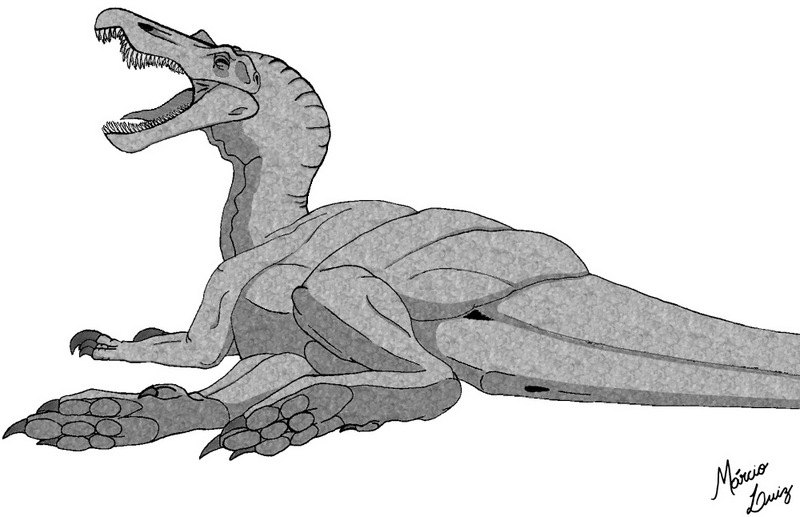Baryonyx
From Wikipedia, the free encyclopedia
[Photo] Life restoration of a sleepy Baryonyx. Author M??rcio Luiz
Baryonyx /bæ.riː'??n.??ks/ meaning "heavy claw", referring to its large claw (Greek barus meaning 'heavy' and onyx meaning 'claw' or 'nail') was a carnivorous dinosaur discovered in clay pits just south of Dorking, England, and northern Spain. The major part of the skeleton of a juvenile specimen was found in England, while the Spanish fossils consist mainly of a partial skull and some fossil tracks. This dinosaur apparently ate fish because remains of its last meal were discovered fossilised in its ribcage. It has been dated to the Barremian period of Early Cretaceous Period, around 125 million years ago.
Description
Baryonyx was about 8 to 10 m (26 to 33 ft) long , and around 3.6 m (12 ft) tall and probably weighed in the region of 2,000 kg. However, analysis of the bones suggests that the most complete specimen was not yet fully grown, so Baryonyx may have grown even larger.
Baryonyx had a large claw on the thumb of each hand, which measured at about 31 cm (12 in). Its long neck was not as strongly S-curved as in many other theropods. The skull was set at an acute angle, not the 90° angle common in similar dinosaurs. The long jaw was distinctly crocodilian, and had 96 teeth, twice as many as its relatives. Sixty-four of the teeth were placed in the lower jaw (mandible), and 32 large ones in the upper (maxilla). The snout probably bore a small crest. The upper jaw had a sharp angle near the snout, a feature seen in crocodiles that helps to prevent prey from escaping. A similar feature is also seen in shrikes.
Discovery and naming
During the early Cretaceous, Wealden Lake covered the majority of what is now northern Europe. Alluvial plains and deltas spread from the uplands surrounding the area where London now stands and eventually ran into this great lake.
Baryonyx was discovered in these former deltas. In January 1983, an amateur fossil hunter named William Walker came across an enormous claw sticking out the side of a clay pit, Smokejacks Pit at Wallis Wood, Ockley near Dorking in Surrey. He received some help in retrieving the specimen, which was surprisingly intact.
The skeleton was passed to Alan J. Charig and Angela C. Milner of the Natural History Museum in London. They published their description of the type species, B. walkeri, in 1986, and named it after Walker.
About 70% of the skeleton was recovered, including the skull. Therefore palaeontologists can make many useful deductions about Baryonyx from just a single find. The skeleton can be seen at the Natural History Museum in London.
Some years after the discovery in England, a partial skull of Baryonyx was found in the Sala de los Infantes deposit of Burgos Province, Spain. Some of the famous and abundant dinosaur fossil tracks of La Rioja, near Burgos, have been identified as tracks of Baryonyx or other theropod genus, very similar to it.
Classification
There is little debate about classification. There is a similarity to the tetanuran Becklespinax, but there is no evidence that Baryonyx had similar elongated spines on the back of its neck.
Another crocodile-like fish-eater, Suchomimus, was described in 1998, and placed in the same subfamily (Baryonychinae). It has recently been suggested (Hutt, 2004) that Suchomimus tenerensis should be redefined as Baryonyx tenerensis due to similarities in their vertebrae. The subfamily Baryonychinae is a subdivision of the family Spinosauridae, which contains other giant Cretaceous forms from Africa and South America like the genera Spinosaurus and Irritator. Probably, spinosaurids appeared in the ancient austral continent of Gondwana and had its major diversification in Africa, colonizing Western Europe through the Iberian Peninsula later.
Paleoecology
The crocodile-like jaws and large number of finely serrated teeth suggested to scientists that Baryonyx was a fish-eater. As confirmation, a number of scales and bones from the fish Lepidotes were also discovered in the body cavity of the English specimen.
It is speculated that Baryonyx would sit on a riverbank, resting on its powerful front legs, and then sweep fish from the river with its powerful striking claw. This is similar to the modern grizzly bear. The long but low stance and angled head support this theory.
Until the discovery of the closely-related Suchomimus, Baryonyx was the only known piscivorous (fish-eating) dinosaur. On the other hand, bones of an Iguanodon were also found in association with the Baryonyx skeleton. Although not definitive proof, it seems possible that Baryonyx scavenged any extra meat it could find.
http://en.wikipedia.org/wiki/Baryonyx
| The text in this page is based on the copyrighted Wikipedia article shown in above URL. It is used under the GNU Free Documentation License. You may redistribute it, verbatim or modified, providing that you comply with the terms of the GFDL. |
|

